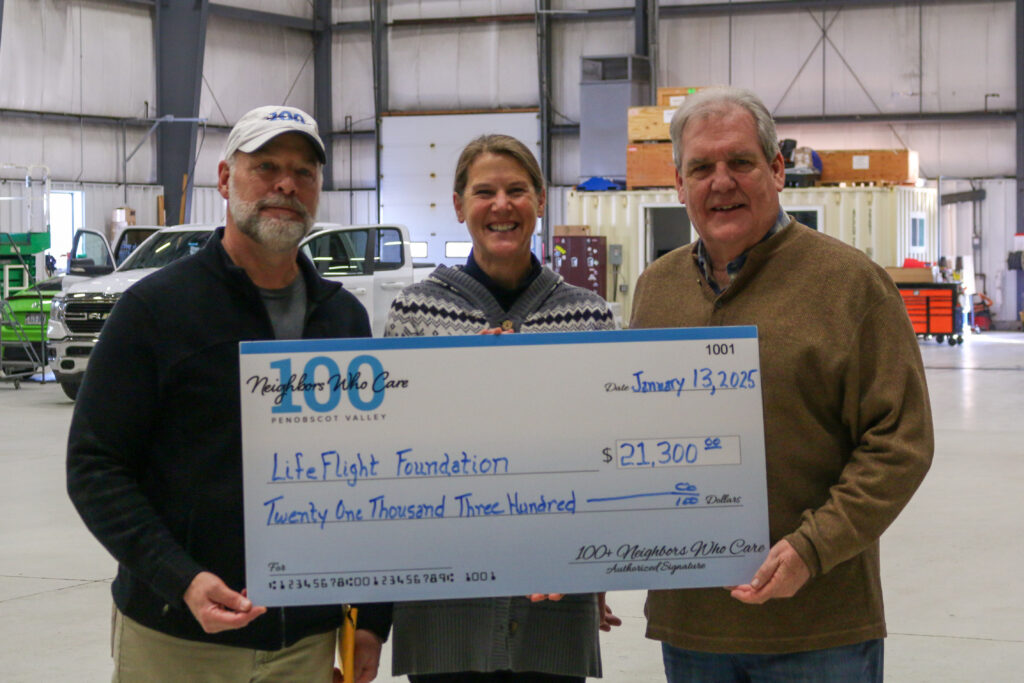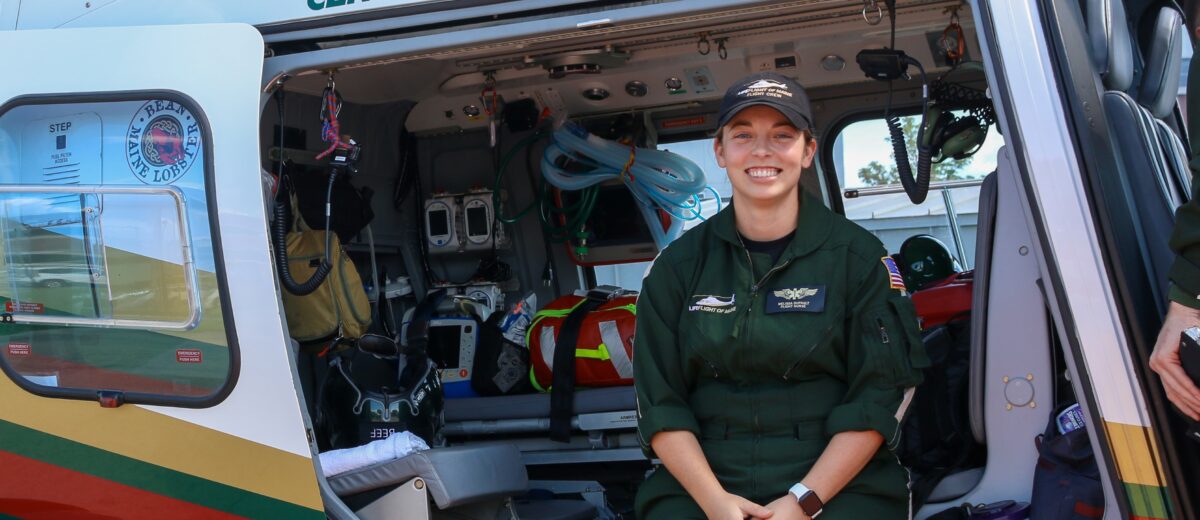The Greatest Job in the World
By Melissa Dufault
In December 2024, flight nurse Melissa Dufault gave the speech below at 100 Neighbors Who Care of Penobscot Valley’s quarterly meeting. She offered her perspective about working as a flight nurse and what being a part of LifeFlight means to her. After her presentation, 100 Neighbors Who Care selected LifeFlight as their recipient charity, making a generous donation of $22,000.
Thank you to Terrance Cain for nominating LifeFlight and thank you to the members of 100 Neighbors Who Care for your generous support!
My name is Melissa Dufault and I have the greatest job in the world. A common response when I say I’m a flight nurse, is: “Wow, I can’t imagine the terrible things you see!” And for that reason, sometimes I’ll say I’m a flight attendant (which isn’t really untrue). But, how do I look a stranger in the eye and tell them I see love in its truest form as a husband kisses his wife goodbye? I see courage win over fear as a parent hands me their child, and I see the deep resilience of a community as they help their neighbor.
We live in what is technically the most rural state in America. I know, I was skeptical too, but it’s based off the percent of the population that lives in a rural area. We Mainers sure like our distance. LifeFlight is crucial in making sure Mainers are receiving the care they need as soon as possible.
LifeFlight of Maine is the only EMS flight company in the state of Maine. We are a private nonprofit organization that works in tandem with public safety, 911 services, and local hospitals. With four active crews at all times, we can transport by helicopter, airplane, or ground ambulance depending on patient needs and access. Two of those crews reside in Bangor, with the other two in Lewiston and Sanford. We transport patients of all ages, from 0 to 100-years-old, and help an average of 2,500 patients a year — that’s one patient every three and a half hours.
Eight percent of our call volume is what we term “scene calls.” These calls are what most people envision — landing on the interstate or on a remote access point in the woods, as well as responding to snowmobile accidents or medical events on the islands. The other 92 percent of our calls are interfacility, or hospital to hospital, which means the sending facility has met their ability to care for the patient and specialty care is required. For example, a patient may need an intensive care unit, surgical intervention, obstetrics care (for high-risk pregnant mothers), neonatal intensive care, or trauma services. A patient may also be experiencing a time sensitive issue — like a heart attack or stroke. Of note, there are only two facilities in Maine that provide 24-hour surgical interventions for heart attacks and strokes — Eastern Maine Medical Center in Bangor and Maine Medical Center in Portland. Eight percent of those interfacility transports are to Boston for complex cancer care, advanced cardiac devices, specialized pediatrics, eye injuries, major burns, and amputations.
Our medical crew is made up of one paramedic and one nurse. We equate our care to bringing the trauma bay doors to the patient. Under protocols and the guidance of our LifeFlight medical directors we are given a wider scope of practice than other nurses and paramedics. This allows us to start the critical care needed when we walk through the door. Having traveled the country and witnessed other programs, I can say LifeFlight has some of the most advanced critical care transport providers in the country.
So why do we need your help?
While operational expenses are covered by insurance reimbursement, our capital investments like aircraft, medical equipment, aviation infrastructure, and clinical education are covered by fundraising.
Since LifeFlight of Maine’s start in 1998, the goal has always been to provide critical care to everyone in the State of Maine who needs it. I’m proud to be employed by a healthcare organization that works hard to ensure our patient costs remain as low as possible. We never want costs to be a barrier to the care someone needs on what is often a terrible day. Through our charity care program, we provide $300,000 a year to patients who are uninsured or underinsured. Last year $2.8 million went uncollected and has been absorbed by the company. We are of Maine and for Maine. Help us continue to bring the best care we can to our neighbors.
Trying to encompass LifeFlight of Maine in a ten-minute speech is nearly impossible. I hope at the very least you’ve learned something new about the green helicopters in the sky. I know many of you likely have a LifeFlight story and, being the rural community we are, it’s hard not to have a first or secondhand story. I’ll end with one of mine:
I was 12 years old. My brother was 22 and loved everything cars. He was racing at Oxford Plains Speedway when he spun into the infield directly in front of us. He was then hit on the driver side by another car going approximately 60mph. Our mother was brought onto the field in the pace car, for what she assumed would be the last time she saw her son. I remember being so angry as our father walked me away. I knew I could help my brother if they just let me. Then I saw the helicopter land.
They managed his injuries and transported him to Maine Medical Center’s trauma ICU, where I was still not allowed to see him for reasons my 12-year-old self didn’t understand yet. Thanks to the LifeFlight crew’s care and speedy transport that day, my brother finally came home to his eager little sister just two weeks later. Today, almost 20 years later, I’m honored to say that I get to fly with the same pilot who flew my brother.
Thank you!

Members of the board of 100 Neighbors Who Care of Penobscot Valley visited LifeFlight’s Bangor hangar to drop off their donation.

